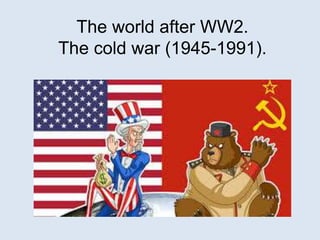
1. The world after ww2. the cold war
- 1. The world after WW2. The cold war (1945-1991).
- 2. The consequences of WW2 • Roughly 50 to 65 million people lost their lives during the war, most of them civilians. • About 70 million people were wounded. • The USSR suffered the highest number of casualties (29 million deaths). • Infrastructures such as bridges, factories, ports, railways etc were greatly destroyed.
- 3. A new world order • Fascism had been defeated, and it was only prevalent in Spain. • Two superpowers emerged: the USSR and the United States. The latter, a democracy; the USSR, a communist regime. • Some borders were altered: - the USSR occupied areas in Western Poland, and also Estonia, Latvia and Lithuania. - However, Poland incorporated some areas of Germany in the West. - Korea was divided in two: the North of communist influence, and the South of American influence.
- 4. What to do with Germany? • Before the end of WW2, a number of conferences took place to decide the post-war situation of Germany and Eastern Europe. • In the Yalta conference (February 1945), Roosevelt, Churchill and Stalin decided the partition of Germany into four military zones: British, French, Soviet and American. • The city of Berlin would also be divided into four military zones. • In Yalta, the powers also decided the boundaries of Poland and Germany.
- 5. Churchill, Roosevelt and Stalin in Yalta
- 6. At the Potsdam conference (July-August 1945) Attlee (the new British Prime Minister), Stalin and Truman (the new President of the US): - confirmed the division of Germany and Berlin in four military zones. - agreed that Germany should be demilitarised. - agreed that Nazi war criminals should be punished.
- 7. The Nuremberg trials • For the first time, an international military tribunal judged some of the most important nazi criminals for war crimes against humanity. • Some were declared innocent, others guilty. Ten were executed.
- 8. The creation of the United Nations • The allies also decided the creation of the United Nations, which replaced the League of Nations. • The headquarters are in New York. • Its objective is to mantain peace in the world (sending troops is an option to reach that goal), and the defence of human rights. • The main decissions could be vetoed by China, the United States, France, the USSR and the UK.
- 9. The cold war
- 10. What was the cold war? • It was a period of permanent tension between the USSR and the United States, (two countries with different political and economic regimes) that lasted from 1947 until 1991. The capitalist bloc led by the US supported a free market, capitalism and freedom. The communist bloc led by the USSR supported a dictatorial state directed by a communist party, and planned economy.
- 11. • However, both blocs possessed nuclear weapons, so a direct war between the US and the USSR never took place. • The US and the USSR tried to control large areas of the world ideologically. In Europe: - most of the Eastern countries in Europe were under the direct control of the USSR, and communist dictatorships were established (Romania, Czechoslovakia, Hungary, Poland, Bulgaria, etc.). - The Western countries (France, the UK, Belgium, the Netherlands, Ireland, Italy, etc.) became Parliamentary democracies.
- 12. • The French, British and American military zones of Germany became a united country: the Federal Republic of Germany. • However, the Soviet military zone became a different country: the German Democratic Republic. Federal Republic of Germany German Democratic republic
- 13. • Berlin remained divided in two: East Berlin (communist) and West Berlin. • In August 1961, a wall was built by the communist in Berlin dividing the two sectors. It was not possible to cross the wall, and East Berlin stayed isolated.
- 14. The military alliances • In 1949, NATO was created by the Western countries to support themselves in case any of its members suffered an attack by the communist bloc. • In 1955, the Warsaw pact was signed between the USSR and its allies in Europe. The communist bloc isolated itself from the rest of the world, divided by the Iron curtain (el telón de acero)
- 15. The arms race• Each bloc competed with the other to produce large number of weapons, especially nuclear weapons. • The goal was to overcome the other bloc, and be ready for a nuclear war between the two superpowers.
- 16. During the cold war, moments of great tension occurred: a) The Cuban missile crisis: - In 1962, the USSR planned to set up nuclear missiles in Cuba (a communist country at the time). - President John Fitzgerald Kennedy threatened the Soviet Union with using nuclear weapons if the USSR did not give up their plan. - Finally, Nikita Kruschev (the Soviet Prime Minister) agreed to withdraw from his original plan.
- 17. b) The Korean war. - In 1950, comunist North Korea invaded the South. - The United States sent troops to help South Korea, and finally the US invaded the North, also threatening communist China. - The United Nations intervened, and the borders were restablished to the original lines.
- 18. c) The Vietnam war - France had to leave Vietnam in 1954 after being defeated by the Vietnam nationalists. - The country was divided in two: North Vietnam (communist) and South Vietnam. - A communist guerrilla (the Vietcong) was created in the South so that the right-wing government of South Vietnam would disappear. - The United States supported the South, but the Vietcong guerrillas made the Americans suffer great losses. The USSR supported the North and the Vietcong. - Finally, the US had to leave the war as it was impossible for them to defeat the guerrillas in the jungle.